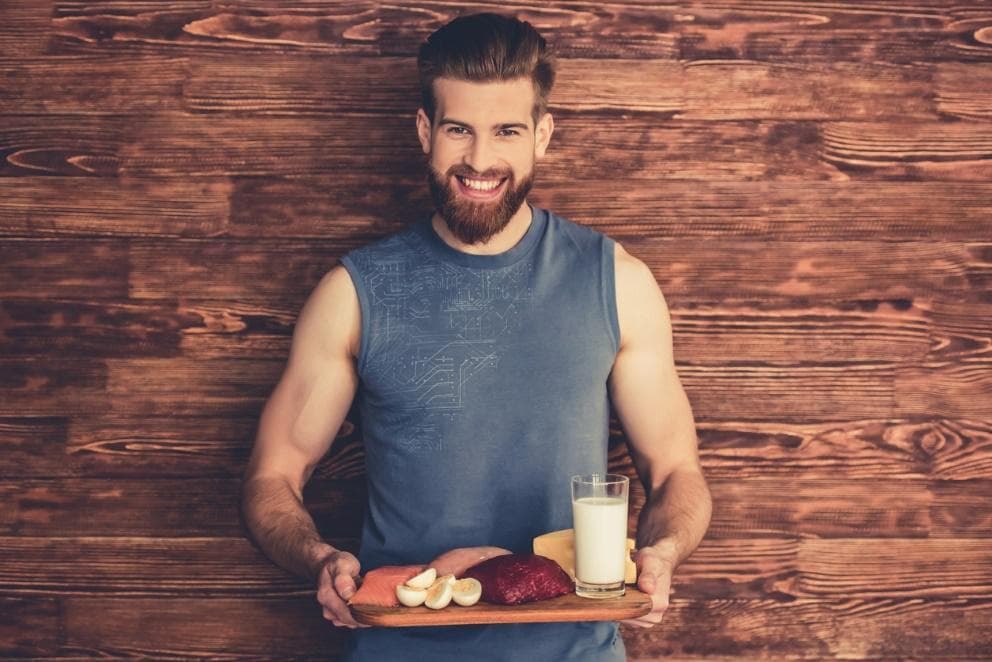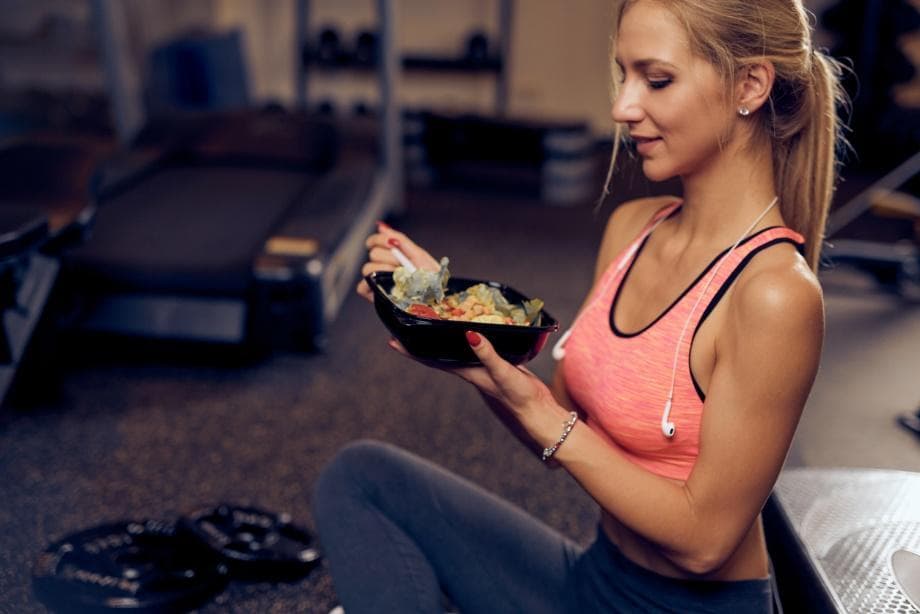10 de October de 2022
What To Eat for Muscle Growth?
Strength training is a basic pillar to gain muscle mass, but we need is a second basic pillar for such muscle growth to occur. A properly designed diet will allow you to gain muscle mass, accumulating as little fat as possible. In this diet it is necessary to control the calories ingested, as well as the macronutrients (protein, carbohydrates and fats) that form those calories. In this article we will expose in detail the current requirements that are recommended to develop muscle mass.
Calories: the fundamental piece of the diet for muscle growth
For muscle growth we have to eat more calories than we spend, that is a law of thermodynamics sine quo non to gain muscle. Eric Helms places the energy balance at the base of the nutrition pyramid (Helms et al., 2019). Macronutrients (protein, carbohydrates and fats) and micronutrients (vitamins and minerals) occupy the second and third place in this pyramid, respectively.
The time in which we eat the foods and supplements used also have a hole in the pyramid, but we should only take care of them when everything else is perfect.
Throughout the day we spend energy on vital tasks such as breathing, blood circulation, brain functioning, etc. To that energy we add the expense of moving out of training: walking to work, cleaning the floor, etc., and also the expense of training. Finally, our body uses energy to digest the food we eat, absorb it and accumulate it in the corresponding places.
To gain muscle mass we need to generate a surplus of energy, which will be higher or lower depending on our level of training. If we´re just starting, we can put more calories because we have more potential for improvement. The opposite happens if we are advanced, a situation in which we will adjust the extra calories more.
An average of about 350 – 500 kcal above the daily maintenance energy expenditure are recommended generically for muscle growth, without accumulating much fat in the process (Crampton, 1964). If we want to individualize a little more, depending on the level of training we can use the following recommendations (Aragon & Schoenfeld, 2020):
- Beginners Recommended daily surplus: 400 – 700 kcal
- Intermediate: Recommended daily surplus: 300 – 500 kcal
- Advanced: Recommended daily surplus: 200 – 400 kcal
Protein: the building blocks of muscle growth

Protein is the basis of muscle growth. Imagine you’re going to build a wall, so you need bricks, workers, and cement. Protein is the building blocks that are part of that wall, without them you couldn’t do anything. It happens if we don’t consume protein, our muscle fiber doesn’t have enough bricks to grow, so, despite training and training, that wall will be built much slower.
A very recent meta-analysis concluded that the appropriate dose to gain muscle mass is at least 1.5g of protein per kilo of weight per day (Tagawa et al., 2022). From there, that value can be increased if we train with a lot of volume, so the recommended range is from 1.5g to 2.2g of protein per kilo of weight a day (Aragon & Schoenfeld, 2020).
What to eat for muscle growth: protein-rich food
The protein can be of animal or vegetable origin. For muscle growth we are more interested in animal protein because it is better absorbed and has more protein per amount of food (Gilani, Xiao, & Cockell, 2012). The whole egg is one of the best sources of protein that we should consume to gain muscle mass. It is important to consume it complete and cooked, and not only the white, since with the same amount of protein it generates a greater synthesis of protein in the muscle (Van Vliet et al., 2017).
Whole milk is another food to eat for muscle growth. It’s a quick and interesting way to add protein to your diet. Other dairy products such as natural yogurts or cheese also stand out for their high protein content. Meat and fish can´t be missed if we want to gain muscle mass, but for our health better choose fish than meat, and that meat should be poultry (turkey and chicken) instead of red meat (veal, pork, etc.).
There are also plant food rich in protein, soy being the most common. Some legumes such as chickpeas, beans, peanuts and peas are also high-protein options, especially for vegetarians and vegans. Some seeds such as hemp or pumpkin seeds also have an interesting amount of protein. To compensate for its worse absorption and digestion, it is advisable to consume a greater amount of these plant foods to equate it with animal protein (Gorissen et al., 2017).
Protein powder supplements are an option that we can use to increase the amount of protein consumed throughout the day. If we reach the daily requirements discussed above it is not necessary to use these supplements. If we are going to make use of protein powder, we must place whey protein first.
Carbohydrates: muscle growth workers

For the wall we are building we need energy in the form of workers. Carbohydrates are necessary for strength work, as they give us that quick energy we need in lifts. As with protein, if there aren’t enough workers, the wall will be built slower.
The range of carbohydrate requirements is between 3 and 7g of carbohydrates per weight per day (Henselmans, Bjørnsen, Hedderman, & Vårvik, 2022). It’s a very wide range that will depend on our lifestyle and the number of strength sessions we do a week. The greater the physical wear and tear of training, the result is better. If we have a sedentary job and do not do many strength sessions, we will go to the lower end.
What to eat for muscle growth: foods rich in carbohydrates
Rice is the food that is not missing in the diet of any bodybuilder because it contains 81% carbohydrates. Wheat is the richest cereal in carbohydrates, and we can consume it in the form of bread or pasta. The base of carbohydrates will be formed by these two foods, rice being preferable to pasta.
Oatmeal is another food to eat for muscle growth, for its high level of carbohydrates, and for its mixture of proteins and fats. There are other very healthy and interesting foods to gain muscle mass, but less used, such as gofio, couscous, millet, buckwheat or quinoa.
Vegetables and fruits are very dense foods because they have a lot of vitamins and minerals and have very few calories. That has an advantage and a disadvantage when it comes to incorporating them into our diet for muscle growth. The advantage is that our body fulfills its functions optimally if we give it the minerals and vitamins it needs. The disadvantage is that in a high-calorie volume diet it becomes difficult to add foods like broccoli, for example. In any case, we must consume vegetables and fruit at each meal.
Sugar and honey are the two pure carbohydrate foods that we can find, but that are not interesting at the health level. Carbohydrate supplements are used to add calories to the diet when we have to ingest very high amounts. Except in the case of expert bodybuilders, it is preferable to eat carbohydrates from foods rich in this macronutrient instead of making use of supplements.
Greases: the cement that makes everything fit together

Healthy fats are a great source of vitamins and minerals, in addition to other active components, which make our body work perfectly. We already have the bricks and the workers; the fats that cement that make everything fit perfectly and enhances muscle growth.
Although experts recommend a range between 1 – 2g of fat per kilo of weight (Aragon & Schoenfeld, 2020), the important thing is that we reach at least the minimum of the said range, and from there we complete it according to our preferences (Iraki, Fitschen, Espinar, & Helms, 2019).
What to eat for muscle growth: high-fat foods
Fats consumed for muscle growth should be healthy fats. Trans fats are excluded because they are harmful to health. Instead, we will eat saturated fats that come from foods already mentioned above: dairy and red meat. It is preferable to choose the other two types of fats that we will see below instead of saturated fat, although it does not mean that we should eliminate it completely.
Monounsaturated fats (MUFAs) are highly recommended because they help our body perform basic functions, including promoting muscle mass gain (Mashek & Wu, 2015). Nuts are the main group of foods that we can consume: walnuts, almonds, cashews, etc. Avocado, pure cocoa and variety of seeds are other options rich in monounsaturated fats.
The other type of unsaturated fat is polyunsaturated fat (PUFA). In this group we highlight extra virgin olive oil (EVOO), oily fish and again nuts and seeds. Some of the best oily fish, rich in fat, that we can consume to increase muscle mass are salmon, tuna, mackerel and sardines (Meyer et al., 2003).
Joaquín Vico Plaza
References
Images extracted from iStock and Unsplash
Aragon, A. A., & Schoenfeld, B. J. (2020). Magnitude and Composition of the Energy Surplus for Maximizing Muscle Hypertrophy: Implications for Bodybuilding and Physique Athletes. Strength and Conditioning Journal, 42(5), 79–86. https://doi.org/10.1519/SSC.0000000000000539
Crampton, E. W. (1964). Nutrient-to-Calorie Ratios in Applied Nutrition. The Journal of Nutrition, 82(3), 353–365. https://doi.org/10.1093/JN/82.3.353
Gilani, G. S., Xiao, C. W., & Cockell, K. A. (2012). Impact of antinutritional factors in food proteins on the digestibility of protein and the bioavailability of amino acids and on protein quality. British Journal of Nutrition, 108(SUPPL. 2). https://doi.org/10.1017/S0007114512002371
Gorissen, S. H. M., Burd, N. A., Kramer, I. F., van Kranenburg, J., Gijsen, A. P., Rooyackers, O., & van Loon, L. J. C. (2017). Co-ingesting milk fat with micellar casein does not affect postprandial protein handling in healthy older men. Clinical Nutrition (Edinburgh, Scotland), 36(2), 429–437. https://doi.org/10.1016/J.CLNU.2015.12.011
Helms, E., Morgan, A., Valdez, A., Francisco, J. C. de, Reyes, V., Álvarez, A., & Amazon). (2019). The muscle & strength pyramid: Nutrición.
Henselmans, M., Bjørnsen, T., Hedderman, R., & Vårvik, F. T. (2022). The Effect of Carbohydrate Intake on Strength and Resistance Training Performance: A Systematic Review. Nutrients, 14(4). https://doi.org/10.3390/NU14040856/S1
Iraki, J., Fitschen, P., Espinar, S., & Helms, E. (2019). Nutrition Recommendations for Bodybuilders in the Off-Season: A Narrative Review. Sports (Basel, Switzerland), 7(7). https://doi.org/10.3390/SPORTS7070154
Mashek, D. G., & Wu, C. (2015). MUFAs. Advances in Nutrition, 6(3), 276. https://doi.org/10.3945/AN.114.005926
Meyer, B. J., Mann, N. J., Lewis, J. L., Milligan, G. C., Sinclair, A. J., & Howe, P. R. C. (2003). Dietary intakes and food sources of omega-6 and omega-3 polyunsaturated fatty acids. Lipids 2003 38:4, 38(4), 391–398. https://doi.org/10.1007/S11745-003-1074-0
Tagawa, R., Watanabe, D., Ito, K., Otsuyama, T., Nakayama, K., Sanbongi, C., & Miyachi, M. (2022). Synergistic Effect of Increased Total Protein Intake and Strength Training on Muscle Strength: A Dose-Response Meta-analysis of Randomized Controlled Trials. Sports Medicine – Open, 8(1), 1–12. https://doi.org/10.1186/S40798-022-00508-W/TABLES/4
Van Vliet, S., Shy, E. L., Sawan, S. A., Beals, J. W., West, D. W. D., Skinner, S. K., … Burd, N. A. (2017). Consumption of whole eggs promotes greater stimulation of postexercise muscle protein synthesis than consumption of isonitrogenous amounts of egg whites in young men. The American Journal of Clinical Nutrition, 106(6), 1401–1412. https://doi.org/10.3945/AJCN.117.159855

